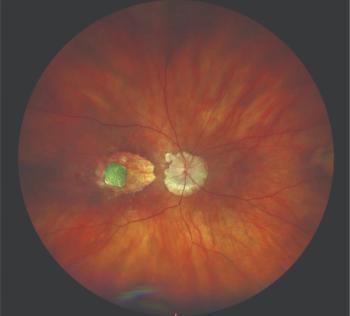
Glaucoma imaging takes its place in clinical practice
Use of imaging in clinical practice offers clinicians a number of advantages for following patients with glaucoma, perhaps most importantly the ability sometimes to detect damage before it is apparent on fundus photographs, objective rates of glaucoma progression, and the ability to predict the patients who are at high risk of functional impairment. Robert N. Weinreb, MD, talked about how imaging and clinical practice are a good fit.
San Diego-Use of imaging in clinical practice offers clinicians a number of advantages for following patients with glaucoma, perhaps most importantly the ability sometimes to detect damage before it is apparent on fundus photographs, objective rates of glaucoma progression, and the ability to predict the patients who are at high risk of functional impairment. Robert N. Weinreb, MD, talked about how imaging and clinical practice are a good fit.
“In the glaucoma continuum, there is progression from an undetectable disease to an asymptomatic one and then to functional impairment,” Dr. Weinreb said. He is Distinguished Professor and Chairman of Ophthalmology, and director, Hamilton Glaucoma Center, University of California, San Diego. “We currently stage the disease and also predict the loss of function by looking at the rates of change and also performing risk assessment in our practices.”
The gold standard for detecting structural progression in patients with glaucoma is comparing serial stereoscopic photographs of the optic disc. Unfortunately, many clinicians do not use this test in clinical practice because it is time-consuming, impractical, and simultaneous stereocameras are not usually available, he explained.
Imaging of the optic nerve and retinal nerve fiber layer enables identification of structural changes in patients with glaucoma and expert examinations by clinicians who are not experts.
“Not only can we stage the disease and predict loss of function, but we also can detect disease progression, looking at event-based change,” he said.
An important benefit with imaging is that the rate of change can be measured in order to estimate the likelihood and severity of the functional loss by trend-based analysis, he emphasized.
“I predict that in the near future, we will be routinely using rates of both functional and structural change in our clinical practices,” he commented.
Imaging has several advantages:
1. Acquisition of images is relatively easy, and because of this, more frequent examinations can be carried out to estimate the rates of change.
2. Reproducibility of the images is excellent.
3. Clinicians can make earlier and more informed clinical decisions.
4. Imaging allows measurement of features that is not possible otherwise.
“Imaging can detect changes in the macular region. The eye has about 1 million retinal ganglion cells, and their numbers are densest in the macula, i.e., about six cells deep; about 50% of the cells are in the central 4.5 mm of the retina, an area that represents only 7% of the total retinal area. This area is not well covered in most visual field testing,” Dr. Weinreb said.
The inner layer of the retina is composed of the nerve fiber layer (the ganglion cell axons), the ganglion cell layer (the cell bodies), and the inner plexiform layer (the dendrites). Spectral-domain optical coherence tomography (SD-OCT) can measure the thickness of the ganglion cell complex so the clinician can evaluate it over time to determine progression of glaucoma.
“Importantly, analysis of the ganglion cells might allow clinicians to detect damage before there are changes in the retinal nerve fiber layer,” Dr. Weinreb said. He demonstrated that analysis showed prominent changes in the ganglion cell analysis were detectable that were not otherwise visible. A number of instruments now have the ability to analyze the ganglion cells, according to Dr. Weinreb.
5. With imaging, clinicians have an objective measure of glaucoma progression.
“Clinicians can look at absolute amounts of retinal nerve fiber loss over time,” he said and showed serial images of a patient in whom the visual field testing was not showing changes but there were changes in the retinal nerve fiber layer images.
6. Data collection is digital.
Digital data collection allows digital data, OCT, and visual field testing to be combined, as can images of the ganglion cell layer with the visual field tests, and analyses that were not previously possible can be done.
7. Rates of progression can be used to predict the patients at highest risk of functional impairment and blindness.
8. SD-OCT imaging allows novel diagnosis of structures previously not analyzed, such as the lamina cribrosa and the choroidal thickness. The new swept-source OCT provides very-high-resolution images of these structures and allows measurement of the choroidal volume.
“Both the World Glaucoma Association consensus initiative and the American Academy of Ophthalmology preferred practice patterns now recommend imaging as part of routine clinical care,” Dr. Weinreb stated.
However, he pointed out, imaging does not take the place of good clinical judgment and consideration of the clinical information. Imaging is not 100% accurate.
In addition, assessment of quality is important, but poor quality is susceptible to artifact.
Using imaging with atypical patients, such as those with high myopia or with a tilted disc, can be problematic.
Normative databases might not represent all patient populations.
And normative databases are based on statistics. There is always a low probability that a patient whose test is outside of normal limits is just “normal” at the low end of the distribution.
So, is there a place for imaging in clinical practice for patients with established glaucoma, especially for assessing disease progression? Dr. Weinreb offered an emphatic “Yes!”
Dr. Weinreb is a consultant to and receives research support from Carl Zeiss Meditec and Optovue and receives research support from Heidelberg Engineering, Topcon, and Nidek.
For more articles in this issue of Ophthalmology Times eReport,
Newsletter
Don’t miss out—get Ophthalmology Times updates on the latest clinical advancements and expert interviews, straight to your inbox.





